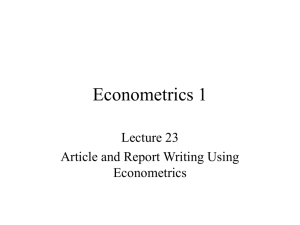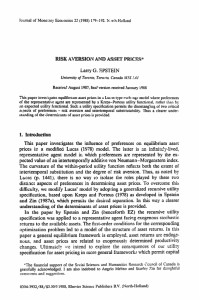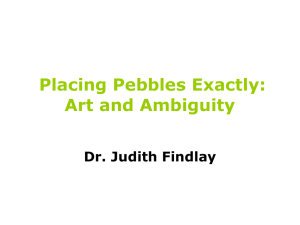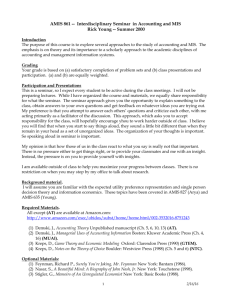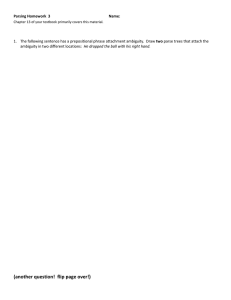EC 718: DECISION THEORY
advertisement
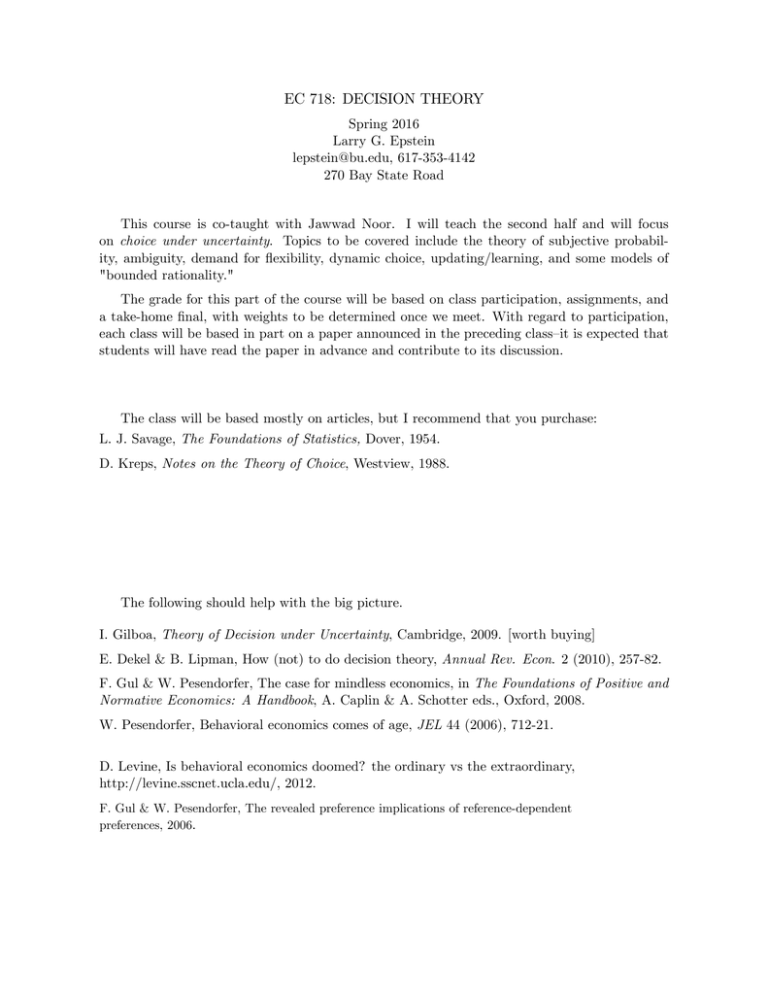
EC 718: DECISION THEORY Spring 2016 Larry G. Epstein lepstein@bu.edu, 617-353-4142 270 Bay State Road This course is co-taught with Jawwad Noor. I will teach the second half and will focus on choice under uncertainty. Topics to be covered include the theory of subjective probability, ambiguity, demand for ‡exibility, dynamic choice, updating/learning, and some models of "bounded rationality." The grade for this part of the course will be based on class participation, assignments, and a take-home …nal, with weights to be determined once we meet. With regard to participation, each class will be based in part on a paper announced in the preceding class–it is expected that students will have read the paper in advance and contribute to its discussion. The class will be based mostly on articles, but I recommend that you purchase: L. J. Savage, The Foundations of Statistics, Dover, 1954. D. Kreps, Notes on the Theory of Choice, Westview, 1988. The following should help with the big picture. I. Gilboa, Theory of Decision under Uncertainty, Cambridge, 2009. [worth buying] E. Dekel & B. Lipman, How (not) to do decision theory, Annual Rev. Econ. 2 (2010), 257-82. F. Gul & W. Pesendorfer, The case for mindless economics, in The Foundations of Positive and Normative Economics: A Handbook, A. Caplin & A. Schotter eds., Oxford, 2008. W. Pesendorfer, Behavioral economics comes of age, JEL 44 (2006), 712-21. D. Levine, Is behavioral economics doomed? the ordinary vs the extraordinary, http://levine.sscnet.ucla.edu/, 2012. F. Gul & W. Pesendorfer, The revealed preference implications of reference-dependent preferences, 2006. #1. SUBJECTIVE PROBABILITY THE SAVAGE MODEL Savage: Chs. 1-6; Kreps: Chs. 4, 8 and 9; Gilboa: Part II M. Machina & D. Schmeidler, A more robust de…nition of subjective probability, Econometrica 60 (1992), 745-780. I. Kopylov, Subjective probability on ‘small’domains, JET 133 (2007), 236-265. I. Kopylov, Simple axioms for countably additive subjective probability, J. Math. Econ. 46 (2010), 867-76. S.H. Chew and J. Sagi, Event exchangeability: probabilistic sophistication without continuity or monotonicity, Econometrica 74 (2006), 771-786. Kreps, Ch. 11: the exchangeable Bayesian model THE ANSCOMBE-AUMANN MODEL Kreps, Chs. 4 (domains of choice), 5 (the mixture-space theorem), Ch. 7 F. Anscombe & R. Aumann, A de…nition of subjective probability, Ann. Math. Stat. 34 (1963), 199-205. Revealed Preference F. Echenique and K. Saito, Savage in the market, Econometrica, 2015 Polisson, Quah and Renou, Revealed preferences over risk and uncertainty, 2015 More overviews & critiques I. Kopylov, Subjective and other probabilities, in Handbook of Probability: Theory and Applications, ed. T. Rudas, SAGE, 2008. N. Al Najjar and L. de Castro, Subjective probability, in The Wiley Encyclopedia of Operations Research and Management Science, 2011. Gilboa, Rationality and the Bayesian paradigm, J. Econ. Methodology, 2014. M. Machina, States of the world and the state of decision theory, 2003. E. Karni, States of nature and the nature of states, 2016. B. Schipper, A note on states and acts in the theory of decisions under uncertainty, 2016. A. Billot, I. Gilboa, D. Samet & D. Schmeidler, Probabilities as similarity-weighted frequencies, Econometrica 73 (2005), 1125-1136; and Gilboa, Part IV. 2 #2. AMBIGUITY/Model Uncertainty D. Ellsberg, Risk, ambiguity and the Savage axioms, QJE 75 (1961), 643-669. Gilboa, Part III. Gilboa, Postlewaite, & Schmeidler, Rationality of belief or: why Savage’s axioms are neither necessary nor su¢ cient for rationality, Synthese 187 (2012), 11-31. M. Siniscalchi, Ambiguity and ambiguity aversion, Palgrave Dictionary of Economics. M. Siniscalchi and M. Machina, Ambiguity and ambiguity aversion, pp. 729-807 in Machina and Viscusi eds., Handbook of the Economics of Risk and Uncertainty (vol 1), 2014. Models I. Gilboa & D. Schmeidler, Maxmin expected utility with non-unique prior, J. Math. Econ. 18 (1989), 141-153. F. Maccheroni, M. Marinacci & A. Rustichini, Ambiguity aversion, robustness and the variational representation of preferences, Econometrica 74 (2006), 1447- 1498. A. Kochov, Time and no lotteries: a simple axiomatization of maxmin expected utility, Econometrica 83 (2015), 239-262. T. Bewley, Knightian decision theory (part I), Decisions in Econ. and Finan. 2002, 79-110. Gilboa et al, Objective and subjective rationality in a multiple prior model, Econometrica 2010. P. Klibano¤, M. Marinacci & S. Mukerji, A smooth model of decision making under ambiguity, Econometrica 73 (2005), 1849-1892. H. Ergin & F. Gul, A theory of subjective compound lotteries, JET 144 (2009), 899-929. Epstein & Seo, Exchangeable capacities, parameters and incomplete theories, JET May 2015. Critiques/extensions M. Machina, Ambiguity aversion with three or more outcomes, AER Dec 2014 K. Saito, Preferences for ‡exibility and randomization under uncertainty, AER March 2015 T. Hayashi et al, Attitude toward imprecise information, JET 140 (2008), 27-65. Experiments/measurements Y. Halevy, Ellsberg revisited: an experimental study, Econometrica 75 (2007), 503-536. S. Trautman and G. van de Kuilen, Ambiguity attitude: a survey of empirical …ndings, in G. Keren and G. Wu (eds.), Handbook of Judgement and Decision Making, Blackwell, forthcoming. U. Gneezy, A. Imas and J. List, Estimating individual ambiguity aversion: a simple approach, 2015. Dimmock, Kouwenberg, Mitchell and Peijnenburg, Ambiguity aversion and household portfolio choice puzzles: empirical evidence, forthcoming JFE. E. Calford, Uncertainty aversion in game theory: experimental evidence, UBC, 2015. Applications S. Mukerji, Ambiguity aversion and incompleteness of contractual form, AER 88 (1998), 1207-31. Epstein and Schneider, Ambiguity and asset markets, Ann. Rev. Finan. Econ. vol 2, 2010. S. Condie & J. Ganguli, Ambiguity and rational expectations equilibria, Restud (2011), 821-845. A. Di Tillio, N. Kos and M. Messner, The design of ambiguous mechanisms, 2012. A. Wolitzky, Mechanism design with max-min agents: theory and an application to bilateral trade, TE. Chiesa, Micali, and Zhu, Knightian analysis of the Vickrey mechanism, Econometrica 2015. A. Ellis, Condorcet meets Ellsberg, TE. Epstein, Kaido and Seo, Robust con…dence regions for incomplete models, Econometrica 2016. 3 #3. DEMAND FOR FLEXIBILITY/Subjective States Kreps: A representation theorem for preference for ‡exibility, Econometrica 47 (1979), 565-578; Static choice in the presence of unforeseen contingencies, in Essays in Honour of F. Hahn, P. Dasgupta et al eds., MIT Press, 1992. Dekel, Lipman & Rustichini, A unique subjective state space for unforeseen contingencies, Econometrica 69 (2001), 891-934. Corrigendum with T. Sarver (2006). D. Ahn and T. Sarver, Preference for ‡exibility and random choice, Econometrica (2013), 341-61. H. Ergin and T. Sarver, A unique costly contemplation representation, Econometrica (2010), 1285-1339. Amador, Werning and Angeletos, Commitment vs ‡exibility, Econometrica 2005. K. Saito, Preferences for ‡exibility and randomization under uncertainty, AER March 2015 C. Chambers, A.D. Miller and B. Yenmez, Closure and preferences, 2015. T.C. Koopmans, On ‡exibility of future preference, Cowles Foundation, 1964, 243-254. K. Hyogo, A subjective model of experimentation, JET 2007. N. Takeoka, Subjective probability over a subjective decision tree, JET 2007. Dillinberger, Lleras, Sadowski and Takeoka, A subjective theory of learning, JET 2014. R.V. Krishna and P. Sadowski, Dynamic preference for ‡exibility, Econometrica 82 (2014), 655-703. #4. RISK and TIME L. Selden, A new representation of preference over ‘certain x uncertain’consumption pairs, Econometrica 46 (1978), 1045-60; and Rev. Econ. Stud. 46 (1979), 73-82. Kreps and Porteus, Temporal resolution of uncertainty and dynamic choice theory, Econometrica 46 (1978), 185-200. Epstein & Zin, Substitution, risk aversion and the temporal behavior of consumption and asset returns: a theoretical framework, Econometrica 57 (1989), 937-969. Epstein, Farhi and Strzalecki, How much would you pay to resolve long-run risk? AER 2014. Gul, Pesendorfer and P. Natenzon, Random evolving lotteries and intrinsic preference for information, 2016. Dejarnette, Dillinberger, Gottleib and Ortoleva, Time lotteries, 2015. Nonrecursive models A. Caplin and J. Leahy, Psychological expected utility and anticipatory feelings, QJE 2001, 65-80; and The supply of information by a concerned expert, Econ. J. (2004), 487-505. K. Eliaz and R. Spiegler, Can anticipatory feelings explain anomalous choices of information sources?, Games Econ. Behav. (2006), 87-104. Epstein, Living with risk, Restud 2008. E. Lipnowski and L. Mathevet, Disclosure to a psychological audience, NYU, 2015. Experiments Andreoni and Sprenger, Risk preferences are not time preferences, AER 102 (2012), 3357-76. This generated Comments in AER 105 (2015) by: (i) Epper and Fehr-Duda, 2261-71; and (ii) Bin Miao and Songfa Zhong, 2272-86. T. Meissner and P. Pfei¤er, I want to know it now: measuring preferences over the temporal resolution of consumption uncertainty, 2015 4 #5. DYNAMIC CHOICE, UPDATING/LEARNING Risk M. Machina, Dynamic consistency and non-expected utility models of choice under uncertainty, JEL 27 (1989), 1622-1668. P. Ghirardato, Revisiting Savage in a conditional world, ET 20 (2002), 83-92 A. Tversky and D. Kahneman, Judgement under uncertainty: heuristics and biases, Science 185 (1974), 1124-1131 N. Al-Najjar and E. Shmaya, Learning the ergodic decomposition, July 2014 N. Al Najjar and E. Shmaya, Uncertainty and disagreement in equilibrium models, JPE 2015. N. Al Najjar, Decision-makers as statisticians: diversity, ambiguity and learning, Econometrica 77 (2009), 1339-1369. P. Ortoleva, Modeling the change of paradigm: non-Bayesian reactions to unexpected news, AER 2012. Ambiguity Gilboa and Schmeidler, Updating ambiguous beliefs, JET 59 (1993), 33-49. M. Marinacci, Learning from ambiguous urns, Statistical Papers 43 (2002), 143-51 Epstein & Schneider: Recursive multiple-priors, JET 113 (2003), 1-31 Learning under ambiguity, Rev. Econ. Stud. 2007 Ambiguity, information quality and asset pricing, J. Finance 2008 E. Asparouhova, P. Bossaerts, J. Eguia & W. Zame, Asset pricing & asymmetric reasoning, JPE 2015. Epstein and Seo, Symmetry of evidence without evidence of symmetry, TE 2010 J. Stoye, New perspectives on statistical decisions under ambiguity, Ann. Rev. Econ. vol 4, 2012. Karni and Viero, Reverse Bayesianism, AER 2013. Gilboa, Samuelson & Schmeidler, The dynamics of inductive inference in a uni…ed framework, JET 2013. Gilboa and Samuelson, Subjectivity in inductive inference, TE 2012. Gilboa, Samuelson and Schmeidler, Analogies and Theories: Formal Models of Reasoning, Oxford 2015. 5 #5. "BOUNDED RATIONALITY" & More Attention A. Ellis, Foundations for optimal inattention, 2016. H. Oliveira, Axiomatic foundations for entropic costs of attention, 2014. Denti, Oliveira, Mihm, and Ozbek, Rationally inattentive preferences and hidden information costs, Dec 2015. A. Caplin and M. Dean, Revealed preference, rational inattention and costly information acquisition, Aug 2014; Rational inattention, and state dependent stochastic choice, 2013. And Caplin, Rational inattention and revealed preference: the data-theoretic approach to economic modeling, Research in Economics Dec 2014. Foresight J. Rust, Do people behave according to Bellman’s principle of optimality, 1992. D. Kreps. Anticipated utility and dynamic choice, in D. Jacobs, E. Kalai and M. Kamien eds. Frontiers of Research in Economic Theory, Cambridge U. Press, 1995. Shaowei Ke, Boundedly rational backward induction, 2015. Shaowei Ke, Mistakes, welfare and risk, 2015. A. Kochov, Small world representations and a behavioral de…nition of unforeseen contingencies, 2014. More Tversky and Kahneman, The framing of decisions and the psychology of choice, Science 211 (1981), 453-8. D. Ahn & H. Ergin, Framing contingencies, Econometrica 78 (2010), 655-695. R. Spiegler, Bayesian networks and boundedly rational expectations, QJE 2016. A. Ellis and M. Piccione, Complexity, correlation and choice, 2016. Fudenberg, Strack & Stzralecki, Stochastic choice and optimal sequential sampling, 2015. F. Echenique & K. Saito, Response-time and utility, 2015 6



